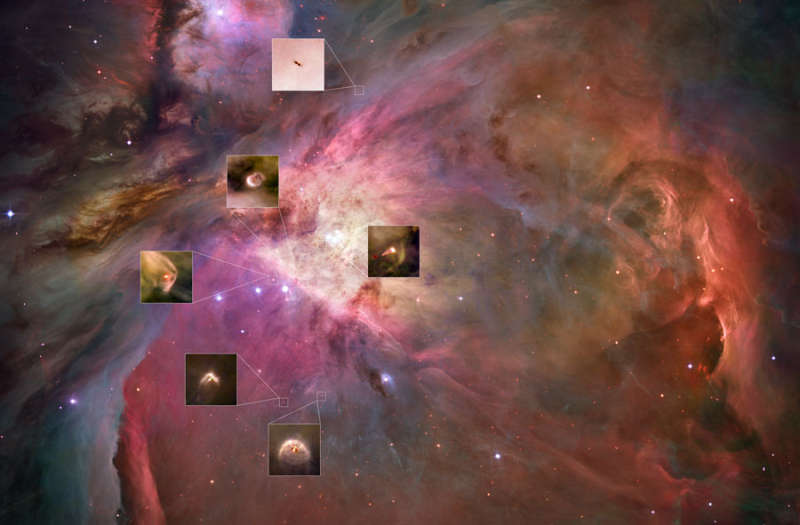
|
Credit & Copyright: NASA,
ESA,
M. Robberto
(STScI/ESA),
the HST Orion Treasury Project Team, &
L. Ricci
(ESO)
Explanation:
How do planets form?
To help find out, the
Hubble Space Telescope
was tasked to take a detailed look
at one of the more interesting of all astronomical
nebulae, the Great Nebula in Orion.
The Orion nebula, visible with the
unaided eye near the
belt in the
constellation of Orion,
is an immense nearby
starbirth region and
probably the most famous of all astronomical nebulas.
Insets to the above mosaic show
numerous proplyds, many of which are stellar nurseries likely harboring
planetary systems in formation.
Some proplyds glow as close disks surrounding bright stars light up, while other
proplyds
contain disks further from their host star, contain cooler
dust, and hence appear as dark
silhouettes against brighter gas.
Studying this dust, in particular, is giving insight for how planets are forming.
Many proplyd images also show
arcs that are
shock waves
- fronts where fast moving material encounters slow moving gas.
The Orion Nebula lies about 1,500
light years distant and is located in the same
spiral arm of
our Galaxy
as our Sun.
|
January February March April May June July August September October November December |
| ||||||||||||||||||||||||||||||||||||||||||||||||
NASA Web Site Statements, Warnings, and Disclaimers
NASA Official: Jay Norris. Specific rights apply.
A service of: LHEA at NASA / GSFC
& Michigan Tech. U.
Based on Astronomy Picture
Of the Day
Publications with keywords: planet formation - Orion Nebula
Publications with words: planet formation - Orion Nebula
See also:
- APOD: 2025 April 20 Á The Orion Nebula in Visible and Infrared
- APOD: 2025 February 19 Á HH 30: A Star System with Planets Now Forming
- APOD: 2024 November 4 Á M42: The Great Nebula in Orion
- APOD: 2024 September 10 Á Horsehead and Orion Nebulas
- Trapezium: At the Heart of Orion
- APOD: 2023 October 10 Á Hidden Orion from Webb
- Orion and the Running Man
